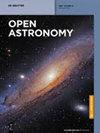星系盘上方气体结构的Hα辐射
IF 0.5
4区 物理与天体物理
Q4 ASTRONOMY & ASTROPHYSICS
引用次数: 0
摘要
在许多边缘星系中发现了电离气体的面外结构。究竟是HII区域还是超新星(SNe)造成了它的电离,目前仍有争议。在这里,我们考虑由位于圆盘中部或中部以上的星团中的超新星爆炸驱动的超气泡壳的H α {\rm{H}}\alpha发射率。我们发现这些壳形成丝状结构,在H α {\rm{H}}\alpha线中发光,在的高度为~ 0.6 \sim 0.6 - 1.6 kpc 1.6,这取决于星团的位置和气体金属丰度。H α \hspace{0.33em}{\rm{kpc}}{\rm{H}}\alpha表面亮度范围在~ 10−17 \sim 10{^}-{17 -}1 0−16 erg s -1 cm−2 arcsec -2 10{^-}16^{-1^}\hspace{0.33em}{\rm{erg}}\hspace{0.33em}{{\rm{s}}}-2{^}\hspace{0.33em}{{\rm{cm}}}-{2}\hspace{0.33em}{{\rm{arcsec}}},{接近}于在边对星系中观测到的值。我们的结论是,H α {\rm{H}}\alpha的面外结构发射可以用多重SNe驱动的不稳定壳层碰撞电离气体中的重组来解释。本文章由计算机程序翻译,如有差异,请以英文原文为准。
Hα emission from gaseous structures above galactic discs
Abstract Extraplanar structures of ionized gas are detected in numerous edge-on galaxies. Whether HII regions or supernovae (SNe) responsible for its ionization is still debated. Here, we consider the H α {\rm{H}}\alpha emissivity from shells of superbubbles driven by SNe explosions in a stellar cluster located either in the midplane or above the midplane of the disc. We found that these shells form filamentary structures emitting brightly in H α {\rm{H}}\alpha line at height of ∼ 0.6 \sim 0.6 – 1.6 kpc 1.6\hspace{0.33em}{\rm{kpc}} above the disc depending on cluster location and gas metallicity. The H α {\rm{H}}\alpha surface brightness ranges within ∼ 1 0 − 17 \sim 1{0}^{-17} – 1 0 − 16 erg s − 1 cm − 2 arcsec − 2 1{0}^{-16}\hspace{0.33em}{\rm{erg}}\hspace{0.33em}{{\rm{s}}}^{-1}\hspace{0.33em}{{\rm{cm}}}^{-2}\hspace{0.33em}{{\rm{arcsec}}}^{-2} are close to the values observed in edge-on galaxies. We conclude that the H α {\rm{H}}\alpha emission of extraplanar structures can be explained by recombination in collisionally ionized gas of unstable shells driven by multiple SNe.
求助全文
通过发布文献求助,成功后即可免费获取论文全文。
去求助
来源期刊

Open Astronomy
Physics and Astronomy-Astronomy and Astrophysics
CiteScore
1.30
自引率
14.30%
发文量
37
审稿时长
16 weeks
期刊介绍:
The journal disseminates research in both observational and theoretical astronomy, astrophysics, solar physics, cosmology, galactic and extragalactic astronomy, high energy particles physics, planetary science, space science and astronomy-related astrobiology, presenting as well the surveys dedicated to astronomical history and education.
 求助内容:
求助内容: 应助结果提醒方式:
应助结果提醒方式:


